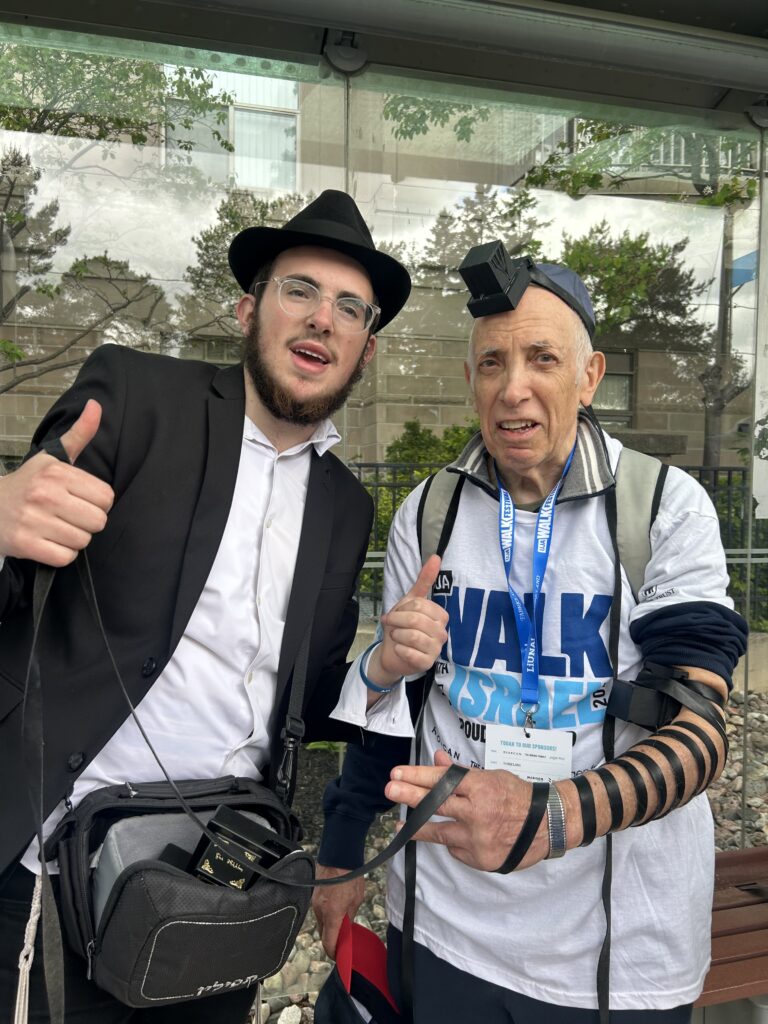Uncategorized
The real Jewish history behind Netflix’s ‘Transatlantic’ and the WWII rescue mission that inspired it
(JTA) — While the United States swung its door shut to most refugees during World War II, a young American in France saved thousands, including some of the 20th century’s defining artists and thinkers — such as Marc Chagall and Hannah Arendt — from the Nazis.
The rescue mission of Varian Fry, which went largely unrecognized during his life, is the subject of Netflix’s new drama “Transatlantic,” launching Friday from “Unorthodox” creator Anna Winger.
Starring Cory Michael Smith as Fry, the seven-episode “Transatlantic” aims to recreate his operation in Marseille after the Nazis defeated France and before the United States entered the war. Winger has injected several imagined romances, war efforts and characters into the fictionalized series, including one posed as Fry’s lover, named Thomas Lovegrove (played by Israeli Amit Rahav). Although Fry’s son has said that he was a “closeted homosexual,” no such person is known to have existed.
Winger believes these inventions will invite Netflix viewers to learn more about the true story.
“The people who lived through these stories are dying out,” she told the Jewish Telegraphic Agency. “My job is to bring this to a wide audience, to people who don’t know anything about it.”
The story behind the series
The real Varian Fry, a 32-year-old journalist and suit-clad Harvard graduate, showed up in Marseille with $3,000 taped to his leg and a list of 200 names in August 1940.
After France surrendered to Germany, Fry was among 200 Americans — including journalists, artists, museum curators, university presidents and Jewish refugees — to create the Emergency Rescue Committee at the Hotel Commodore in New York. This group was concerned with Article 19 in France’s armistice with Germany, which required French authorities to surrender any individuals demanded by the Germans.
The private relief organization drew up frenzied lists of anti-Nazi intellectuals who were trapped in France. With the help of first lady Eleanor Roosevelt, the ERC obtained some emergency visas and sent Fry to lead the rescue efforts in Marseille, a port city in the southern, unoccupied part of France.
What he found there was impossible to manage alone. His mission began in his room at the Hotel Splendide, where long lines of refugees waited in the morning before he woke up and at night after he went to bed. They sometimes walked straight into his bedroom without knocking, Fry wrote in a letter to his wife shortly after he arrived.
Gathering a small devoted staff, including Frenchmen, refugees and American expatriates, Fry moved his office to Rue Grignan and later Boulevard Garibaldi. Outside of Marseille he rented the Villa Air-Bel — colorfully recreated in “Transatlantic” — to house eminent writers and eccentric Surrealist artists waiting for visas.
The group developed legal and illegal branches, with the cover organization offering humanitarian relief while a behind-the-scenes operation flouted the law to help refugees escape. Using Marseille’s lively black market, the staff found hiding places, forged documents and bribed officials. Bil Spira, a Jewish Austrian-born cartoonist, forged passports for the ERC. (He was caught and deported to Auschwitz, but survived.) Resistance fighters Hans and Lisa Fittko devised an escape route to Spain, guiding refugees across the Pyrenees mountains on foot.
By the time he was forced out in October 1941, Fry’s shoestring operation had enabled 2,000 Jewish and other anti-Nazi refugees to flee Europe, including such towering artists as Chagall, Max Ernst and Marcel Duchamp, and intellects such as Arendt, Heinrich Mann and André Breton. It has been estimated that 20,000 refugees made contact with the rescue center in Marseille.
Fry’s illegal efforts made him plenty of enemies from his own country, who accused him of interfering with American neutrality in the war. He angered the state department, officials at the American consulate in Marseille and ERC members in New York. In August 1941, he was arrested by Vichy police and sent back to New York.
Fry died in 1967 at the age of 59. Only a few months earlier, he had received the Croix de Chevalier de la Legion d’Honneur, France’s highest decoration of merit — and the only official recognition in his lifetime. In 1994, he became the first American honored by Yad Vashem, Israel’s Holocaust memorial and history authority, as Righteous Among the Nations.
The Emergency Rescue Committee merged with another relief organization and became the International Rescue Committee in 1942. It is still in operation today and currently led by a Jewish CEO, former British politician David Miliband.
What’s in the show, and why some are against it
Some of Fry’s colleagues are fictionalized in “Transatlantic,” including the Jewish Berliner Albert Hirschman (Lucas Englander), who would become an economist in the United States; the Chicago heiress Mary Jayne Gold (Gillian Jacobs); and the Jewish Austro-Hungarian activist Lisa Fittko (Deleila Piasko). American diplomat Hiram Bigham, who gave Fry crucial help and even hid writer Lion Feuchtwanger in his home, is also a character in the show.
Throughout the seven episodes, rescue missions swirl around a series of fictional love affairs. In addition to Fry’s relationship, a triangle unfolds between Hirschman, Gold and the fictional American Consul Graham Patterson. (There is no evidence that Gold romanced either with her comrade or with any American consul in Marseille.) Lisa Fittko has an affair with the fictional character Paul Kandjo, who organizes armed resistance to Vichy.
Gillian Jacobs as heiress Mary Jayne Gold. (Anika Molnar/Netflix)
Several wartime plot points are also invented, including a prison break at Camp de Mille and Gold’s collaboration with British intelligence.
The degree of fictionalization has angered some people close to the real history. Pierre Sauvage, president of the Varian Fry Institute, called the show’s trailer “shocking.” Born in 1944, Sauvage survived the end of the Holocaust in the French village of Le Chambon-sur-Lignon, although his Jewish parents were turned down by Fry’s overwhelmed committee. He became close friends with some of Fry’s fellow rescuers in their later years, including the late Gold, Hirschman and Fittko.
“Are there any red lines?” he said. “Can one fictionalize at will, with no concern for the reality of the story, for the false impression that people will get — and for the way it affects the private lives of the families of people portrayed?”
Sheila Isenberg, who documented Fry’s operation in her book “A Hero of Our Own,” has described the series as a “travesty.” Thomas Fischer Weiss, a child survivor who attempted Fry’s escape route through the Pyrenees at 5 years old, also said the historical events needed no embellishment.
“I think you should tell it straight,” he told the JTA.
The legacy of the ‘troublemakers’
Sauvage believes that if Fry and his associates were alive today, they would like to be remembered for their convictions.
“These were people who were sort of in your face,” he said. “People who knew clearly what they felt and expressed it. They would often describe themselves as troublemakers. Mary Jayne [Gold] said about Varian that he was an ‘ornery cuss’ — it took orneriness to stick to your guns.”
That orneriness was critical at a time when many Americans were apathetic to the plight of European Jews — a 1938 poll in Fortune magazine found that fewer than 5% believed the United States should raise its immigration quotas for refugees. By the summer of 1941, it was too late to open the doors. The German policy of expelling Jews had changed into extermination.
According to Sauvage, America’s refusal to accept more refugees had something to do with that shift.
“The Nazis could legitimately come to the conclusion that the world wouldn’t do anything about the murders and wouldn’t really care all that much,” he said. “What the Varian Fry mission symbolizes is people who cared.”
Varian Fry with Miriam Davenport in the first offices of the Centre Américain de Secours in Marseille in 1940. Davenport, a friend of Mary Jayne Gold, also worked in the rescue effort but is omitted from “Transatlantic.” (Varian Fry Institute)
After their year in Marseille, the rescuers settled into more ordinary lives. Hirschman became an economist with appointments at Yale, Columbia and Harvard. Lisa Fittko ended up in Chicago, where she worked hard in import-export, translation and clerical jobs to earn money, eventually joining protests against the Vietnam War. Gold divided her time between New York City and a villa on the French Riviera.
They all remembered the rescue mission as their finest hour. Speaking with Sauvage, Gold called that year “the only one in her life that really mattered.”
A refugee story for troubled times
Fry’s rescue mission inspired Julie Orringer to write “The Flight Portfolio,” a 2019 novel that became the basis for “Transatlantic.” Orringer was captivated by the image of a young man arriving in Marseille, idealistic and unprepared for the depth of anguish he would find.
“The task was way too big,” she told the JTA. “He realized quite early on that he was going to ask for help, that he was going to have to turn to others who had deeper experience. And in collecting this group of incredible individuals around him, he assembled a kind of collective mind that really could make a difference under the very difficult circumstances that he faced.”
She believed that Fry left an example for the inexperienced. “If you‘re the kind of person who wants to take action on behalf of refugees, but doesn’t know how to do it, ask for help,” she said.
Winger, a Jewish Massachusetts native who has lived in Berlin for two decades, conceived of making a series about Fry in 2015. Germany saw an influx of more than a million migrants that year, most of them fleeing Syria’s horrific civil war. She optioned Orringer’s book in 2020.
“I thought a lot about the fact that people like us — artists, Jews, both — had to leave Berlin as refugees, but now there were so many people coming to Berlin as refugees,” said Winger.
Then, just as she started filming “Transatlantic” on location in Marseille, a new war broke out in Europe.
“The war in Ukraine started three days into the production and there was a whole other wave of refugees coming to Berlin,” she said. “Suddenly we were making it in another refugee crisis.”
Russia’s invasion of Ukraine hit close to the show, whose cast and crew hail from across the continent. Winger’s cinematographer is married to a Ukrainian woman. In Berlin, she saw thousands of refugees crowding into the central train station, some without shoes, food or plans for shelter.
“I think it gave us all a strong sense of purpose,” said Winger.
—
The post The real Jewish history behind Netflix’s ‘Transatlantic’ and the WWII rescue mission that inspired it appeared first on Jewish Telegraphic Agency.
Uncategorized
How the Global Religious Landscape Changed from 2010 to 2020

Muslims grew fastest; Christians lagged behind global population increase
• Christians are the world’s largest religious group, at 28.8% of the global population. They are a majority everywhere except the Asia-Pacific and Middle East-North Africa regions. Sub-Saharan Africa has surpassed Europe in having the largest number of Christians. But Christians are shrinking as a share of the global population, as millions of Christians “switch” out of religion to become religiously unaffiliated.

• Muslims are the world’s second-largest religious group (25.6% of the world’s population) and the fastest-growing major religion, largely due to Muslims’ relatively young age structure and high fertility rate. They make up the vast majority of the population in the Middle East-North Africa region. In all other regions, Muslims are a religious minority, including in the Asia-Pacific region (which is home to the greatest number of Muslims).

• The religiously unaffiliated population is the world’s third-largest religious category (24.2% of the global population), after Christians and Muslims. Between 2010 and 2020, religiously unaffiliated people grew more than any group except Muslims, despite their demographic disadvantages of an older age structure and relatively low fertility. The unaffiliated made up a majority of the population in 10 countries and territories in 2020, up from seven a decade earlier.
• Hindus are the fourth-largest religious category (14.9% of the world’s population), after Christians, Muslims and religiously unaffiliated people. Most (99%) live in the Asia-Pacific region; 95% of all Hindus live in India alone. Between 2010 and 2020, Hindus remained a stable share of the world’s population because their fertility resembles the global average, and surveys indicate that switching out of or into Hinduism is rare.
• Buddhists (4.1% of the world’s population) are the only group in this report whose number declined worldwide between 2010 and 2020. This was due both to religious disaffiliation among Buddhists in East Asia and to a relatively low birth rate among Buddhists, who tend to live in countries with older populations. Most of the world’s Buddhists (98%) reside in the Asia-Pacific region, the birthplace of Buddhism.
• Jews, the smallest religious group analyzed separately in this report (0.2% of the world’s population), lagged behind global population growth between 2010 and 2020 – despite having fertility rates on par with the global average – due to their older age structure. Most Jews live either in North America (primarily in the United States) or in the Middle East-North Africa region (almost exclusively in Israel).
These are among the key findings of a Pew Research Center analysis of more than 2,700 censuses and surveys, including census data releases that were delayed due to the coronavirus pandemic. This report is part of the Pew-Templeton Global Religious Futures project, which analyzes global religious change and its impact on societies around the world. Funding for the Global Religious Futures project comes from The Pew Charitable Trusts and the John Templeton Foundation.
Uncategorized
Antisemitism in some unlikely places in America

By HENRY SREBRNIK Antisemitism flourishes in a place where few might expect to confront it – medical schools and among doctors. It affects Jews, I think, more emotionally than Judeophobia in other fields.
Medicine has long been a Jewish profession with a history going back centuries. We all know the jokes about “my son – now also my daughter – the doctor.” Physicians take the Hippocratic Oath to heal the sick, regardless of their ethnicity or religion. When we are ill doctors often become the people who save us from debilitating illness and even death. So this is all the more shocking.
Yes, in earlier periods there were medical schools with quotas and hospitals who refused or limited the number of Jews they allowed to be affiliated with them. It’s why we built Jewish hospitals and practices. And of course, we all shudder at the history of Nazi doctors and euthanasia in Germany and in the concentration camps of Europe. But all this – so we thought – was a thing of a dark past. Yet now it has made a comeback, along with many other horrors we assume might never reappear.
Since the Hamas attack on Israel on October 7, 2023, there has been a resurgence of antisemitism, also noticeable in the world of healthcare. This is not just a Canadian issue. Two articles on the Jewish website Tablet, published Nov. 21, 2023, and May 18, 2025, spoke to this problem in American medicine as well, referencing a study by Ian Kingsbury and Jay P. Greene of Do No Harm, a health care advocacy group, based on data amassed by the organization Stop Antisemitism. They identified a wave of open Jew-hatred by medical professionals, medical schools, and professional associations, often driven by foreign-trained doctors importing the Jew-hatred of their native countries, suggesting “that a field entrusted with healing is becoming a licensed purveyor of hatred.”
Activists from Doctors Against Genocide, American Palestinian Women’s Association, and CODEPINK held a demonstration calling for an immediate cease-fire in Gaza at the Hart Senate Office Building in Washington, D.C., Nov. 16, 2023, almost as soon as the war began. A doctor in Tampa took to social media to post a Palestinian flag with the caption “about time!!!” The medical director of a cancer centre in Dearborn, Michigan, posted on social media: “What a beautiful morning. What a beautiful day.” Even in New York, a physician commented on Instagram that “Zionist settlers” got “a taste of their own medicine.” A Boston-based dentist was filmed ripping down posters of Israeli victims and a professor at the University of Pennsylvania Perelman School of Medicine did the same. Almost three-quarters of American medical associations felt the need to speak out on the war in Ukraine but almost three-quarters had nothing to say about the war in Israel.
Antisemitism in academic medical centres is fostering noxious environments which deprive Jewish healthcare professionals of their civil right to work in spaces free from discrimination and hate, according to a study by the Data & Analytics Department of StandWithUs, an international, non-partisan education organization that supports Israel and fights antisemitism.
“Academia today is increasingly cultivating an environment which is hostile to Jews, as well as members of other religious and ethnic groups,” StandWithUs director of data and analytics, and study co-author, Alexandra Fishman, said on May 5 in a press release. “Academic institutions should be upholding the integrity of scholarship, prioritizing civil discourse, rather than allowing bias or personal agendas to guide academic culture.”
The study, “Antisemitism in American Healthcare: The Role of Workplace Environment,” included survey data showing that 62.8 per cent of Jewish healthcare professionals employed by campus-based medical centres reported experiencing antisemitism, a far higher rate than those working in private practice and community hospitals. Fueling the rise in hate, it added, were repeated failures of DEI (diversity, equity, and inclusion) initiatives to educate workers about antisemitism, increasing, the report said, the likelihood of antisemitic activity.
“When administrators and colleagues understand what antisemitism looks like, it clearly correlates with less antisemitism in the workplace,” co-author and Yeshiva University professor Dr. Charles Auerbach reported. “Recognition is a powerful tool — institutions that foster awareness create safer, more inclusive environments for everyone.”
Last December, the Data & Analytics Department also published a study which found that nearly 40 per cent of Jewish American health-care professionals have encountered antisemitism in the workplace, either as witnesses or victims. The study included a survey of 645 Jewish health workers, a substantial number of whom said they were subject to “social and professional isolation.” The problem left more than one quarter of the survey cohort, 26.4 per cent, “feeling unsafe or threatened.”
The official journal of the Alliance for Academic Internal Medicine concurs. According to “The Moral Imperative of Countering Antisemitism in US Medicine – A Way Forward,” by Hedy S. Wald and Steven Roth, published in the October 2024 issue of the American Journal of Medicine, increased antisemitism in the United States has created a hostile learning and practice environment in medical settings. This includes instances of antisemitic behaviour and the use of antisemitic symbols at medical school commencements.
Examples of its impact upon medicine include medical students’ social media postings claiming that Jews wield disproportionate power, antisemitic slogans at the University of California, Los Angeles (UCLA) David Geffen School of Medicine, antisemitic graffiti at the University of California, San Francisco (UCSF) Cancer Centre, Jewish medical students’ exposure to demonization of Israel diatribes and rationalizing terrorism; and faculty, including a professor of medicine at UCSF, posting antisemitic tropes and derogatory comments about Jewish health care professionals. Jewish medical students’ fears of retribution, should they speak out, have been reported. “Our recent unpublished survey of Jewish physicians and trainees demonstrated a twofold increase from 40% to 88% for those who experienced antisemitism prior to vs after October 7,” they stated.
In some schools, Jewish faculty are speaking out. In February, the Jewish Faculty Resilience Group at UCLA accused the institution in an open letter of “ignoring” antisemitism at the School of Medicine, charging that its indifference to the matter “continues to encourage more antisemitism.” It added that discrimination at the medical school has caused demonstrable harm to Jewish students and faculty. Student clubs, it said, are denied recognition for arbitrary reasons; Jewish faculty whose ethnic backgrounds were previously unknown are purged from the payrolls upon being identified as Jews; and anyone who refuses to participate in anti-Zionist events is “intimidated” and pressured.
Given these findings, many American physicians are worried not only as Jewish doctors and professionals, but for Jewish patients who are more than ever concerned with whom they’re meeting. Can we really conceive of a future where you’re not sure if “the doctor will hate you now?”
Henry Srebrnik is a professor of political science at the University of Prince Edward Island.
Uncategorized
The 2025 Toronto Walk (and talk ) for Israel

By GERRY POSNER There are walks and then there are walks. The Toronto UJA Walk for Israel on May 25, 2025 was one of a kind, at least as far as Canada and Jews are concerned. The number of people present was estimated to be 56,000 people or 112,000 total shoes. (How they get to that number is bewildering to me, since there is no one counting). This was 6,000 more than last year. Whether it is true or not, take it from me, it was packed. The synagogues in Canada should be so fortunate to get those numbers in total on High Holidays. The picture here gives you a sense of the size of the crowd.

This was my first walk in Toronto for Israel and I was with my granddaughter, Samantha Pyzer (not to forget her two friends whom she managed to meet at the site, no small feat, even with iPhones as aids). The official proceedings began at 9:00 a.m. and the walk at 10:00 a.m. There was entertainment to begin with, also along the way, and at the finish as well. The finish line this year was the Prosserman Centre or the JCC as it often called. The walk itself was perhaps 4 kilometres – not very long, but the walking was slow, especially at the beginning. There were lots of strollers, even baby carriages, though I did not see any wheelchairs. All ages participated on this walk. I figured, based on what I could see on the faces of people all around me that, although I was not the oldest one on the walk, I bet I made the top 100 – more likely the top 20.
What was a highlight for me was the number of Winnipeggers I met, both past and present. Connecting with them seemed to be much like a fluke. No doubt, I missed la lot of them, but I saw, in no particular order (I could not recall the order if my life depended on it): Alta Sigesmund, (who was, a long time ago, my daughter Amira’s teacher), Marni Samphir, Karla Berbrayer and her husband Dr. Allan Kraut and family. Then, when Samantha and I made it to the end and sat down to eat, I struck up a conversation with a woman unknown to me and as we chatted, she confirmed her former Winnipeg status as a sister-in- law to David Devere, as in Betty Shwemer, the sister of Cecile Devere. I also chanced upon Terri Cherniack, only because I paused for a moment and she spotted me. As we closed in near the finish, I met ( hey were on their way back), Earl and Suzanne Golden and son Matthew, as well as Daniel Glazerman. That stop caused me to lose my granddaughter and her pals. Try finding them amid the noise and size of the crowd – but I pulled it off.

As I was in line to get food, I started chatting with a guy in the vicinity of my age. I dropped the Winnipeg link and the floodgates opened with “ Did I know Jack and Joanie Rusen?” So that was an interesting few minutes. And I was not too terribly surprised to come across some of my Pickleball family. All of these meetings, along with spotting some of my sister’s family and other cousins, were carried on with the sound of the shofar as we moved along the way. In short, this was a happening. Merchants selling a variety of products, many of them Israeli based, were in evidence and, of course, the day could not have ended without the laying of tefillin, aided by Chabad, who have perfected the procedure to take less than a minute. See the photo. Chabad had a willing audience.
Aside from the joy of sharing this experience with my granddaughter, the very presence of all these Jews gathered together for a common reason made this day very special to me. However, there was a downside to the day. The downside was that, as we began to walk back to our car there was no other way I could figure out how to return when the rains came and came. While we walked faster, we were impeded by pouring rain and puddles. But Samantha wanted to persevere, as did I. We made it, but were drenched. My runners are still drying out as I write this two days later.
What with being surrounded by 56,000 people, the noise, the slow walking, and the rain, I can still say the day was a real highlight for me – one of the better moments since our arrival in Toronto in 2012. As well as the photos we took along the way, I have the reminder of the day, courtesy of the UJA, as evidenced from the photo. It was not just the walk, but the talk that accompanied the walk that made it so worthwhile for me. I would do it again, minus the rain.
